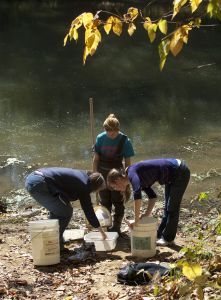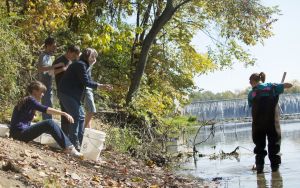From classroom to community: GC students use iPads to communicate water safety

Photos by Alysha Landis.
Goshen College’s alma mater proclaims, “There’s a spot in Indiana where the leafy Maple grows; Tis our dear and glorious Parkside where the Elkhart River flows.”
But how much e-coli and lawn fertilizer are also flowing in the river, and is it safe?
Some Goshen College students are collaborating with community members to monitor the water quality of the nearby Elkhart River – and the students are using their new iPads to do it.
On Oct. 1, Associate Professor of Biology Ryan Sensenig’s Ecology and Evolution class launched a five-week collaborative project between a local company, Hertzler Systems Inc., the Goshen College Informatics and Biology departments and members of the Community Clean Water Project to test the water quality of the Elkhart River. With their new iPads, the students can enter the water quality data they collect at the river directly into their tablets using an app designed by Goshen College sophomore Jacob Shetler during an internship with Hertzler Systems, Inc.
After being entered into the app, the water quality data is automatically uploaded to a server on campus where a software program, donated by Hertzler Inc., compiles the data and presents trends, means and some basic analysis. These data include everything from chemical results to counts of invertebrate species. Students of Sensenig’s biology class will each design a website that communicates these data to the public. The best designs will be selected by Hertzler Systems staff to be implemented with the help of a Goshen College informatics class in the spring.
“This will eventually allow anyone using a mobile device to access weekly water data in real-time in a user friendly way that promotes increased awareness,” said Sensenig.
Out in the field, students sampled macroinvertebrates from the Elkhart River as biological indicators of the quality of the water. Volunteers from the Community Clean Water Project helped the students gather samples. The volunteer group, which was formed about four years ago by Sensenig and local environmental educator Melissa Kinsey, adopted the statewide monitoring program of Hoosier Riverwatch at a local level. The group is made up of community volunteers who monitor the river year-round.
“Our goal is to learn about the quality of the water and to educate interested citizens,” said Kinsey. “We’re interested in creation care, protecting the earth’s resources, being aware of the human impact on the quality of the water and the safety of the water.

With the introduction of the iPad for all first-year students at Goshen College, Sensenig has adjusted the clean water project. “With the iPads, it allows us to emphasize to students the importance of using technology to communicate scientific findings to the public,” he said. “And having the ability to type in data right in the field is a compelling way of using the iPad.”
For many students in the class, this project is an introduction to citizen science. People who fish or boat on the Elkhart River, live along the river or are just concerned citizens will soon easily be able to access the latest information about the river’s water quality.
“It’s important for the students to be able to take everything they learned from class and figure out what are the most important things to communicate, and what is the best way to communicate it in a user-friendly way?” said Sensenig. “It’s not just enough to know the science, but they need to be able to engage the community.”
Evan Miller, of Hertzler Systems, Inc., which has donated thousands of dollars of time and software to the project, said, “At a personal level, as a member of my local community, it feels great to participate in something that brings together town, gown, and business for the good of a community asset, our river.”
— By Alysha Landis




